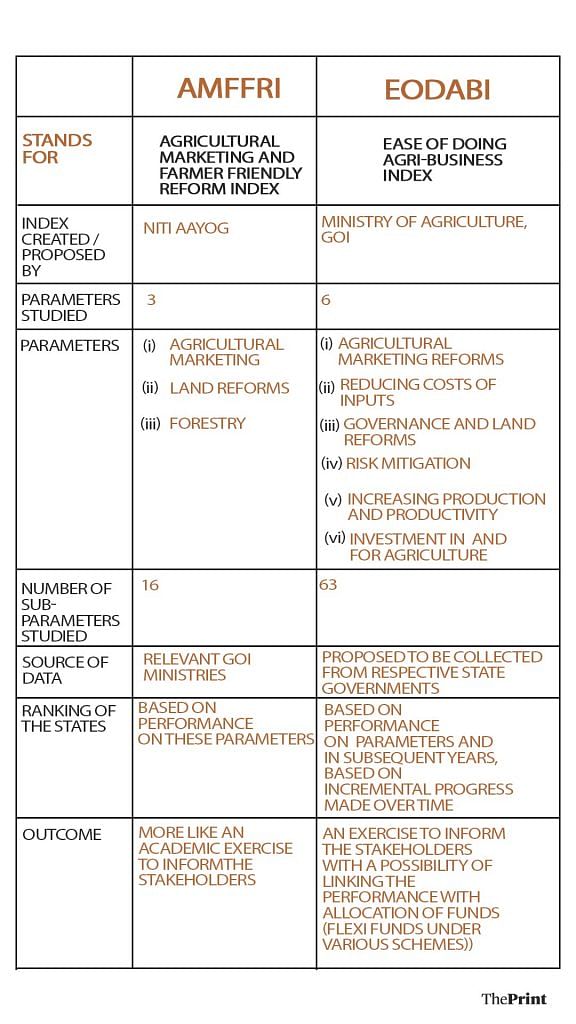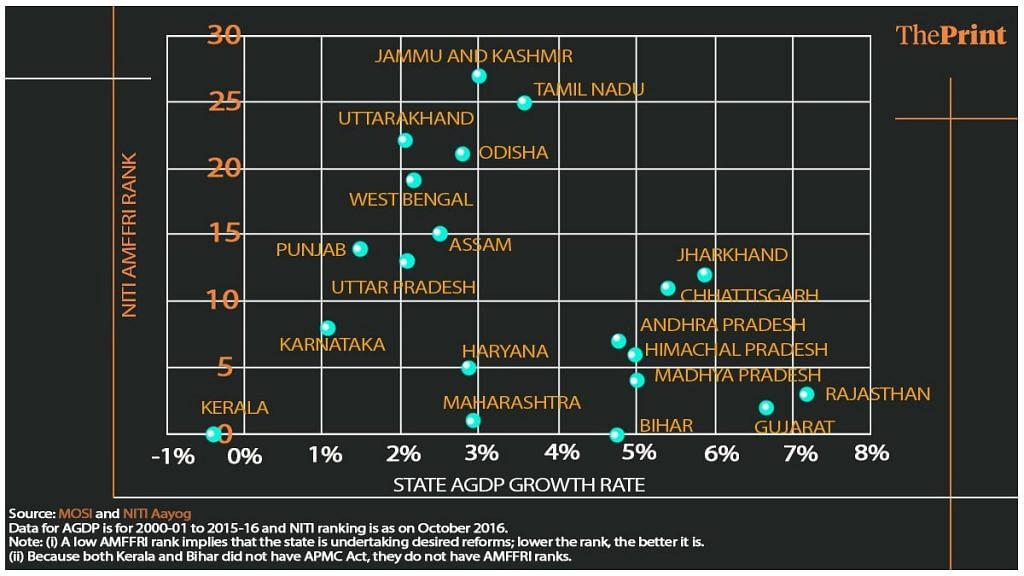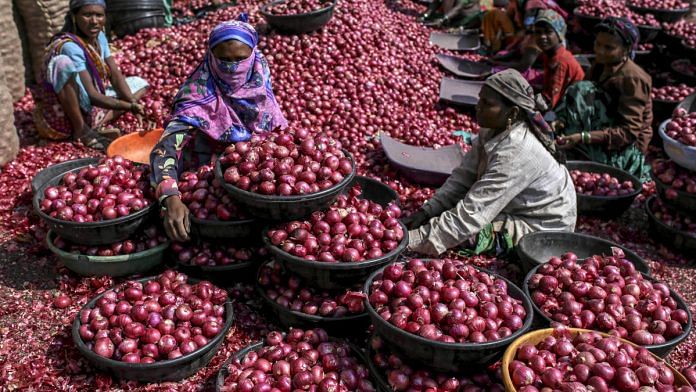Just like India measures Ease of Doing Business, it also needs a measure of the Ease of Doing Agri-business. Even though agriculture employs close to 47 per cent of the country’s workforce, it contributes just 15 per cent to India’s GDP. The agriculture sector needs immediate reforms, but there is little that the Narendra Modi government can do since it is a state subject. Which is where the index will come handy.
Treat farmers as businesspeople
For India, agriculture has always been viewed as a production-oriented activity undertaken to achieve food security for the country. And a farmer as one who must provide cheap food and inputs to all sections of the growing economy and rely on government programmes and schemes for her welfare.
By consistently increasing production and expanding surpluses and offering her crop at very competitive prices, the farmer has proved her mettle as an entrepreneur.
Now it is time that policymakers and the government acknowledge and treat Indian farming as a commercial activity and a farmer as an entrepreneur running it.
In his first term, PM Narendra Modi announced his dream of doubling farmers’ incomes by 2022. The 14-volume, 3,000-page Dalwai Committee Report undertook an extensive and robust exercise to identify about 620 recommendations to achieve that dream, especially the need for states to undertake policy reforms in agri-markets, land tenancy and leasing, and contract farming.
Agriculture in India is a state subject where the central government can only advice state governments on required reforms. These states move at their own varied pace and this may not necessarily align with the pace required nationally. An ease of doing agri-business index will help.
Also read: All that is wrong with Modi govt’s obsession with Ease of Doing Business rankings
India’s ease of doing agri-business index
In October 2016, NITI Aayog launched its Agricultural Markets and Farmer Friendly Reforms Index (AMFFRI). This index evaluates Indian states on three parameters: agricultural market reforms, land lease reforms and reforms related to forestry on private land. Each parameter had sub-parameters.
States are scored based on their performance on these sub-parameters. Based on total score received by a state, ranks are assigned to all states. As per 2016 October AMFFRI, Maharashtra topped the index and Puducherry came last. It means Maharashtra undertook most reforms, while Puducherry did not.
There are three problems with this index:
(i) The index was not updated after October 2016
(ii) The analysis was based on data from relevant central ministries and not state governments
(iii) The activity looks only like an academic exercise as there was no outcome of this initiative.
In November 2018, the central Ministry of Agriculture proposed an ease of doing agri-business index (EODABI). It proposes to study the performance of states under six parameters:
(i) Agri-marketing reforms
(ii) Reducing costs of inputs
(iii) Governance and land reforms
(iv) Risk mitigation
(v) Increasing production and productivity
(vi) Investments in and for agriculture.
It also proposed a new and crucial idea –attaching the state ranking with allocation of additional funds to reward the best performers.
Also read: To stop rupee dive, India needs to move labour away from agriculture
Table: Differences between AMFFRI and EODABI

With an expanded list of parameters, the possibility of performance-based rewards, collection of responses from state governments and by proposing to rank states on their incremental performance, the ease of doing agri-business index emerges to be a reformed version of the NITI’s AMFFRI. But both the indices are dormant at this stage.
Importance of this index
I present a simple statistical exercise below where 20 Indian states, which together comprise 99 per cent of India’s agricultural workforce (as per Census 2011) are studied for two variables:
(i) average agri-GDP (AGDP) growth witnessed by the state between 2000-01 and 2015-16
(ii) their ranks on NITI’s AMFFRI (October 2016).
Figure: Comparing State AGDP growth rates with AMFFRI Rank

It is intriguing to see how the states with the highest AGDP growth rates (x-axis) are ones with low AMFFRI ranks (y-axis). This implies, that states which have undertaken timely and speedy reforms (because of which they have low AMFFRI ranks) have also witnessed faster agri-GDP growth rates.
The opposite is also largely true – states that have not undertaken reforms (and thus have high AMFRRI ranks) have experienced relatively lower agri-GDP growth. There are exceptions like Maharashtra, Karnataka and Haryana who have witnessed lower agri-GDP growth rates and are ranked low, but this could be due to the lagged effect that reforms have on agri-GDP, results of which will be visible in recent agri-GDP data.
Now the question is about causality: was it the reforms that caused agri-GDP to grow faster or was it higher agri-GDP growth that gave states confidence for reforms? This will require an econometric analysis but prima facie, even if one believes that each caused and explained the other, we can reiterate the importance and requirement of states to undertake reforms while doing everything else to improve the farming ecosystem.
An ease of doing agri-business index could become a milestone in the Indian agri-reform history as the results can serve as report cards that can nudge state’s behaviour on reforms.
Also read: Modi govt’s Zero Budget Natural Farming still in trial mode, scientists say not viable
Agricultural reforms are critical for rural economy
Agricultural production in India has been consistently growing. As per estimates from NITI Aayog, marketable surplus (per cent of her total production that she offers for sale in the market) has been rising every year since 2001 by more than 3 per cent. As per the Agricultural and Processed Food Products Export Development Authority, the agricultural trade surplus has been rising every year in the same period by an average of 11.6 per cent. By producing and exporting large quantities of agri-products Indian farmers have helped the country achieve food security at the national level.
It is ironical that despite such growth, Indian farmers continue to lag behind.
Under an ICRIER-OECD research project that I was part of, we studied 19 crops (which comprised of about 67 per cent of India’s agricultural value of output) across 19 years till 2018-19 and found two interesting things: (i) Indian farmers consistently produced their crops at much lower prices than their global counterparts, and (ii) Indian farmers suffered immensely due to these consistently low prices that even after accounting for all the subsidy support they get under government schemes, they were net worse-off.
Among the reasons we found these domestic prices to be low were: problems of small-holder farmers like the problem of aggregation where most farmers brought small pockets of produce and thus lacked power to negotiate, and the inherent consumer-bias in trade policies where every time there was a possibility of prices to rise (and farmers to earn), the government-imposed trading and stocking restrictions and even resorted to cheap imports to diffuse any inflationary pressures.
Outdated and unpredictable laws in land markets, agricultural markets and trade were particularly found to be restraining the growth in the sector, needing immediate reforms.
Also read: Beyond MSPs & loan waivers, Modi govt must make agricultural market reforms its top priority
Making ease of agri-business index more relevant
To enable the index to achieve its goals, in addition to immediate implementation of the index, there are three suggestions.
One, the index monitoring, analysis and reporting should be made an annual affair, so that results are available to the states on time for them to take appropriate action.
Two, connecting performance of states on this index with rewards like additional funds from schemes and programmes will make the whole exercise motivating and trigger competitive spirit between states.
Three, assessment of agri-business activity is missing in the two indices. It is as important to view a farmer as an entrepreneur, as it is to evaluate ‘other’ entrepreneurs in the field. The index should identify, measure and examine agri-business activity environment in a state. So, ease of doing business of agriculture should also be studied.
Indian economy must overcome its current downward phase soon and much of this recovery will come from the rural sector most of whom are dependent on agriculture for their livelihoods. The centrality of reforms, therefore, cannot be overemphasised. Once states undertake required reforms, it will unleash massive unutilised potential of India’s agricultural sector.
India will become the most populous country in the world by 2027, and with risks lurking large due to climate change, it is imperative that states undertake reforms and strengthen its farmers and the agri-ecosystem.
The author is a Senior Consultant with ICRIER. Views are personal.







Unless our farmers are educated he can not be freed from exploiting clutches of market players inspite of packages and subsidies.Education is the key to bring educated farmers in mainstream. Need Agricentric enterprise contextual quality education from school curriculum with farm schools in every cluster of villages to make every farmers as businessman and enhance the income of farmers.
Surplus growth, low cost consumer pro agriculture leads profit in marketing which gives business to the growing market .like Malaysia for Palm growth. Mauritius for sugarcane growing. And China production.
subsidys should be given for all ,irrespective of big small land holders if at all agriculture production be viable.small lands holders are reselling subsidized equipments.
Hello its good intitality plz go forward Modi government. Help women agricultureist.. Tq being our leader
Scrap the APMCs. Allow corporates, including foreign firms, to buy directly from farmers and to market their produce . 2. Lift all restrictions on cattle trade.